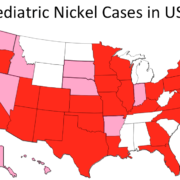Triggers of ACD – allergens and the jewelry addict
Discussion of Triggers of Allergic Contact Dermatitis in Accessories – the Jewelry addict
Original article: Nanette B. Silverberg. (2016). The “Jewelry Addict”: Allergic contact dermatitis from repetitive multiple children’s jewelry exposures. Pediatric Dermatology 33: e103-e105
Reviewed by Lauren A. Ivey, MS. MSI & Brittanya A. Limone, MA, BS. MSIII Loma Linda University
- Nickel Allergic Contact Dermatitis (Ni-ACD) can be a distressing problem, especially for young girls with pierced ears and a love for costume jewelry.
- Nickel is the most commonly confirmed contact allergen in both children and adults.
- Confirmed Ni-ACD has increased 3 to 4-fold since 1986.
- Common sources of nickel exposure in children include jewelry and adornments, electronics, and school chairs.
- Girls are especially at risk to early nickel exposure through earrings and daily us of costume jewelry (aka “jewelry addict”)
- Electronics, eg cell phones, laptops, and tablets have increased the frequency of nickel exposure.
- Silverberg presents a case study of a 9-year-old girl “addicted to costume jewelry” who developed ACD after exposure to different metal- and rubber-containing accessories.
- Confirmed sources of the allergen exposure included rubber bracelets, cheaper metal jewelry, lip balm case and belt buckles.
- Physical examination: classic involvement of the antecubital fossa (crease of arms) consistent with a diagnosis of atopic dermatitis, and lichenified plaques on the fingertips and dorsal hands.
- Notable plaques were seen on the lips and perioral region associated with application of lip balm kept in the metal case.
- Patch testing revealed a 3+ reaction to nickel (papular variant), 2+ to gold thiosulfate, and 3+ to thiuram, all of which were deemed clinically relevant considering the child’s history with jewelry containing these allergens and her presentation.
- Parents and caregivers must remain cognizant of important allergens in jewelry.
- Because virtually any type of jewelry can be a source of allergy, children who exhibit persistent dermatitis should be tested for suspected allergens based on history and exposure.

